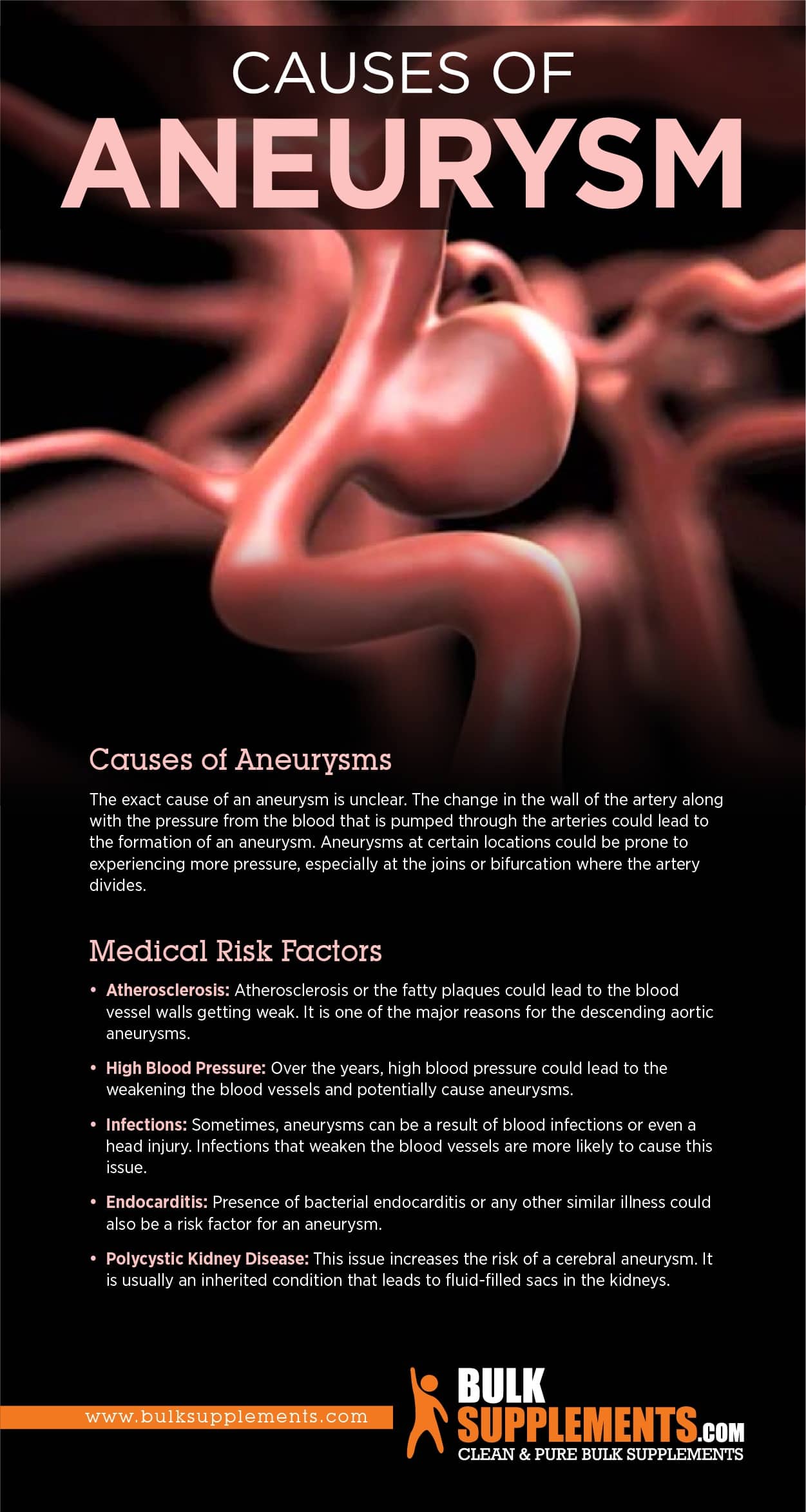Aneurysm: Symptoms, Causes & Treatment

Aneurysm
What is an Aneurysm?
An aneurysm occurs when a section of the body’s artery wall weakens. This could lead to a bulge in a blood vessel, leading to it extending out or ballooning. It could occur in the brain, spleen, intestine, knee or in the aorta. In most cases, the cause of aneurysms remains unknown. Sometimes it could be congenital, which means the person was born with the condition. An existing health condition or a new injury could also lead to an aneurysm. Generally, aneurysms don’t show any symptoms until they rupture.
Once it ruptures, it could prove to be fatal at times since it could lead to internal bleeding and even a stroke if the heart is not strong enough. If your family has a history of aneurysms, children may be at risk for developing the same condition. Other risk factors include high cholesterol, high blood pressure and smoking.
To understand aneurysms, it could help to understand the brain’s circulation. When the heart pumps out oxygen and nutrient-rich blood to the brain, it transports via the internal carotid arteries and the vertebral arteries. The jugular and other veins make the return journey. If these arteries and veins weaken or start to bulge, it could result in an aneurysm.
Types of Aneurysms
Aneurysms can occur anywhere. However, the most common types include cerebral aneurysm, which occurs in the brain, thoracic aortic aneurysm in the chest and abdominal aortic aneurysm in the abdomen. Popliteal artery aneurysm occurs in the area behind the knee while splenic artery aneurysm occurs in the spleen.
Cerebral Aneurysm
This type occurs in a blood vessel in the brain. Since an aneurysm in the brain is not associated with any others in the body, family history does not affect much. This condition is more common in those beyond the age of 60. Since it looks like a small bulge the size of a berry clinging on to the blood vessel, some refer to it as a berry aneurysm. In some cases, these could form in clusters as well. It usually occurs in the front part of the brain, which is responsible for supplying oxygen-rich blood to the tissues there.
Thoracic Aortic Aneurysm
This type of aneurysm involves the aorta in the chest. An aneurysm could lead to the ballooning or bulging of the upper aorta, just above the diaphragm. If one does not receive treatment in time, it could rupture, leading to death. This typically occurs in patients over the age of 70. Thoracic aortic aneurysm involves the aortic root, descending aorta or the thoracoabdominal aorta in very few cases.
Abdominal Aortic Aneurysm
This type of aneurysm affects the aorta in the abdomen. This occurs when the blood vessels in the area that supply blood to the body enlarge. Since the aorta is the largest blood vessel in our body, a rupture could cause internal bleeding, leading to death, if not treated immediately. The aorta makes its way from the heart to the abdomen via the center of the chest. The treatment is usually advised depending on the size and its growth rate.
Symptoms of an Aneurysm?
In most cases, aneurysms don’t show any visible symptoms. Since it develops quite slowly, there is no way one can detect it unless it ruptures or becomes large at a later stage.
Symptoms of Expansion
Most aneurysms start small and don’t expand. However, some do enlarge over time. The speed with which it grows is difficult to determine beforehand. Some symptoms of expansion for a thoracic aortic aneurysm could include back pain, cough, pain in the chest and shortness of breath. For cerebral aneurysms, signs of expansions could be a severe headache, stiff neck, nausea and vomiting. Other symptoms include clammy skin, anxiety, dizziness and low blood pressure.
Ruptured Aneurysm
Ruptured aneurysms could have symptoms like a sudden and severe headache, blurry vision, loss of consciousness and even a seizure.
Unruptured Aneurysm
In most cases, an unruptured aneurysm does not show any symptoms, especially if it is small. Larger ones could lead to numbness, dilated pupils, double vision and headache.
Cerebral Aneurysm
Symptoms for this type of aneurysm include increasing drowsiness, paralysis, neck pain and stiffness, seizures, severe headache, impaired speech and visual problems.
Thoracic Aortic Aneurysm
Signs of a thoracic aortic aneurysm include coughing, breathlessness, swelling of the arms, pain in the chest, back and neck, constricted pupil and drooping of the eyelid and swallowing difficulties.
Abdominal Aortic Aneurysm
Abdominal aneurysms could be signaled by abdominal swelling, nausea, vomiting, pain in the lower back, rapid heart rate, a sensation of a pulse in the abdomen and sweating.
Diagnosis
Most aneurysms don’t show symptoms. They are usually found in x-rays, ultrasounds, angiography and CT scans. In many cases, the patient is usually undergoing a scan for another issue.
Causes of Aneurysms
The exact cause of an aneurysm is unclear. The change in the wall of the artery along with the pressure from the blood that is pumped through the arteries could lead to the formation of an aneurysm. Aneurysms at certain locations could be prone to experiencing more pressure, especially at the joins or bifurcation where the artery divides.
Medical Risk Factors
- Atherosclerosis: Atherosclerosis or the fatty plaques could lead to the blood vessel walls getting weak. It is one of the major reasons for the descending aortic aneurysms.
- High Blood Pressure: Over the years, high blood pressure could lead to the weakening the blood vessels and potentially cause aneurysms.
- Infections: Sometimes, aneurysms can be a result of blood infections or even a head injury. Infections that weaken the blood vessels are more likely to cause this issue.
- Endocarditis: Presence of bacterial endocarditis or any other similar illness could also be a risk factor for an aneurysm.
- Polycystic Kidney Disease: This issue increases the risk of a cerebral aneurysm. It is usually an inherited condition that leads to fluid-filled sacs in the kidneys.
Other Risk Factors
- Age: Age is a major risk factor. They are most common in older patients, usually over the age of 60 or 70.
- Weight: A heavy body weight or obesity could place more pressure on the heart and the artery walls. This could lead to the risk of aneurysm.
- Family History: Family history could also be a risk factor, especially considering heart attack, stroke and heart diseases. Having one in other parts of the body could lead to a thoracic aortic aneurysm.
- Poor Lifestyle Choices: Smoking cigarettes, drug abuse and heavy consumption of alcohol are all high-risk factors for aneurysms.
Complications
- Hemorrhagic Stroke and Coma: Hemorrhage from a ruptured one could lead to coma, hemorrhagic stroke and sometimes even death.
- Hydrocephalus: In the event of one rupturing in the area between the brain and the surrounding tissue, the blood circulation could be blocked, leading to more pressure on the brain.
- Vasospasm: The blood vessels in the brain could narrow post the rupture of a brain aneurysm. This could limit blood flow to the cells, causing more damage.
- Brain Damage: In most cases, a ruptured one will require emergency surgery. For brain aneurysms, surgery will be conducted only if the chance of rupture is high since brain damage is a high risk here.

Treatment for Aneurysms
Treatment for them depends on the severity of the case and the size, location and the situation. Aortic repair could come in many forms.
Diagnosis
Most aneurysms don’t show symptoms. These are usually found in x-rays, ultrasounds or CT scans. In many cases, the patient is usually getting scanned for another issue.
- Angiography: This uses an x-ray or MRI to scan and map the major blood vessels in the body and then use it to understand any issues, such as aneurysms.
- CT Scan: This examination assists in defining the size and condition of the aneurysm with a high degree of accuracy.
- Ultrasound: It is another effective way of determining the size. A Doppler ultrasound may also be useful to analyse the flow of blood through the aorta.
Doctors might sometime advise a wait and watch protocol while in more severe cases, one might require emergency surgery. For brain aneurysms, immediate medical treatment is necessary since it could escalate to dangerous levels very quickly. Brain aneurysms generally don’t rupture or lead to other health issues. A doctor may prescribe medications to soothe underlying issues, such as high blood pressure.
Ruptured Aneurysms
For ruptured aneurysms, one needs to receive medical emergency care as soon as possible. Since it could potentially be fatal, the survival rate is very low if one does not receive immediate treatment.
Treatment Based on Factors
The treatment of the aneurysms usually depends on the type and size of the aneurysm, in addition to its growth rate. The patient’s age, health condition and weight could also be considered. Faster growing or large ones will receive more attention.
SEE ALSO

Ringworm: Symptoms, Causes & Treatment
Open Surgery
Open surgery usually involves fitting a synthetic or stent-graft. It is usually opted if the initial surgery went unsuccessfully.
Endovascular Aneurysm Repair
In this surgery, the blood vessels are accessed by making a small incision near the hip and a catheter is used to inserts an endovascular graft. The aneurysm is then sealed off.
Prevention
To prevent aneurysms, one should stop smoking, manage their cholesterol levels, follow a good diet and maintain their weight. For those having high blood pressure, proper diet and medication are important.
Supplements for Blood Circulation
Supplements are highly effective in promoting blood circulation. It is advisable not to consume over the prescribed limits.
Hawthorn
Hawthorn is a kind of berry that may help to treat circulatory issues and disorders. Hawthorn berry extract can potentially treat chest pain, hardening of the arteries, irregular heartbeat, high blood pressure and heart failure.
Cayenne
Cayenne promotes the flow of blood by expanding your blood vessels and reducing your blood pressure. Cayenne extract may improve blood vessel strength, increase circulation and reduce plaque buildup in the arteries.
Ginger
Ginger root extract powder is used as a traditional medicine in much of Asia for improving circulation and lowering blood pressure.
Butcher’s Broom
Butcher’s broom is a plant that may be useful for treating medical conditions. Some use butcher’s broom extract powder to treat poor blood circulation, varicose veins, itching and even kidney stones and gallstones.
Bacopa
Bacopa is an herb mainly present in southeast Asia that may help increase the flow of blood to the brain.
The Bottom Line
An aneurysm refers to the enlarging or the ballooning of blood vessels due to the weakening of artery walls. An aneurysm can occur anywhere, such as the brain, the area behind the knee, the spleen and the abdomen. Coma, brain damage, Hydrocephalus, and Vasospasm are all indicative of complications with aneurysms. Supplements like bacopa, ginger and cayenne can help improve the blood flow while preventive measure needs to be applied such as stopping smoking and reducing alcohol consumption. Aneurysm treatment ranges from monitoring and taking medication to surgery.



